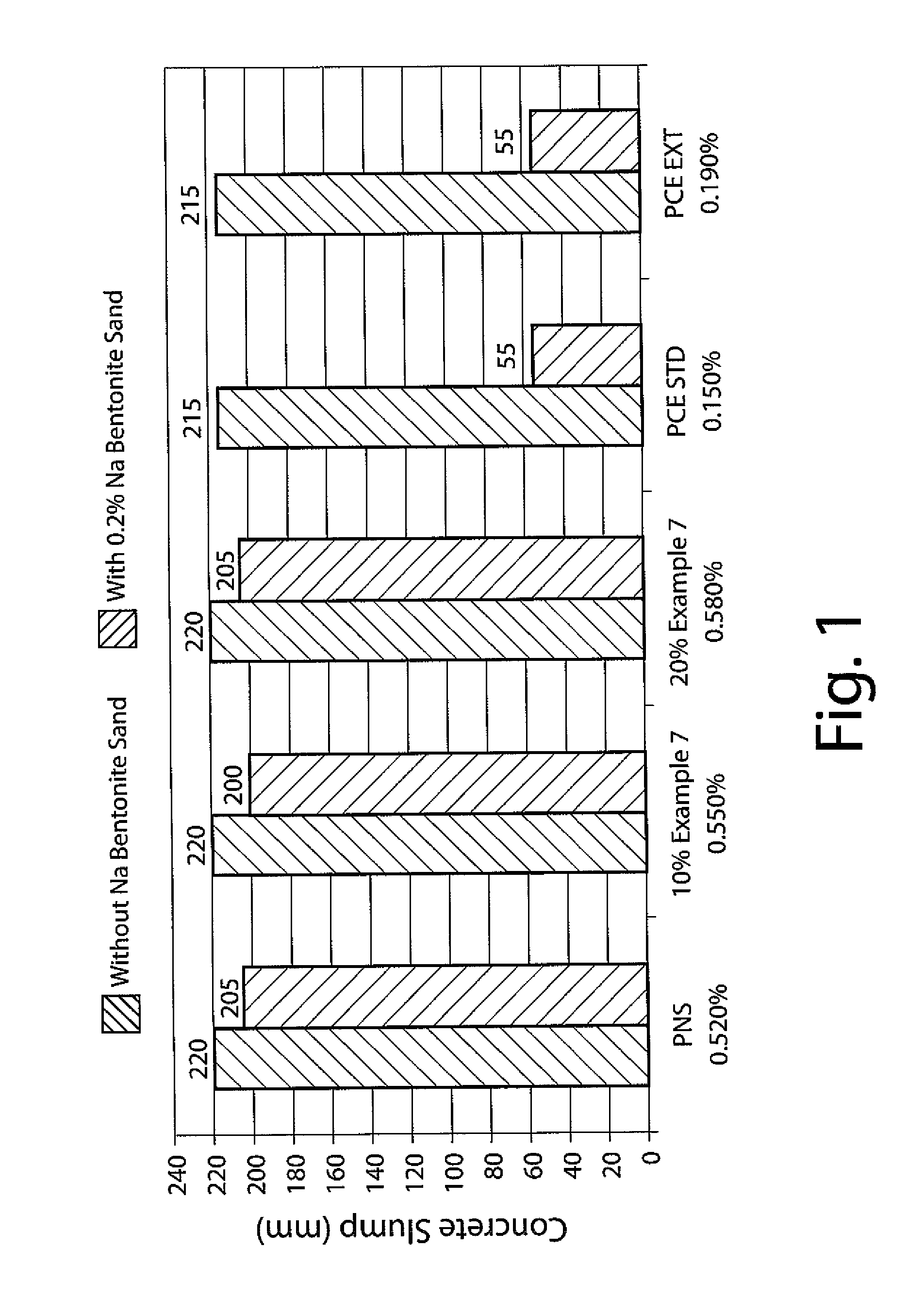Slump Retaining and Dispersing Agent for Hydraulic Compositions
a technology of hydraulic composition and dispersing agent, which is applied in the direction of drilling composition, chemistry apparatus and processes, etc., can solve the problems of reducing the capacity of maintaining slump, increasing the complexity of the user, and adding manpower costs, so as to prevent the setting of the treated composition, the effect of low or no air entraining side effects
- Summary
- Abstract
- Description
- Claims
- Application Information
AI Technical Summary
Benefits of technology
Problems solved by technology
Method used
Image
Examples
examples 1 to 6
Preparation & Evaluation of Copolymers
Synthesis Example Copolymer 1
[0046]The monomers sodium 2-acrylamido-2-methylpropanesulfonate in water solution (650 g), 2-hydroxyethylacrylate (216 g), methacrylic acid (112 g) and 2-mercaptoethanol (15 g) were placed in the stock vessel as a mixture, and 86 g water was added. In another stock vessel, 18.3 g sodium persulfate was dissolved in 184.9 g water to make the initiator solution.
[0047]In a 2 liter reaction glass vessel fitted with a thermometer and a cooling condenser, 418 g of water and a certain amount of monomer mixture were added in the flask in order to obtain a monomer concentration of 15% by weight. The reactor was then heated to 83° C. The monomer mixture and the initiator solution were introduced gradually into the reactor by a metering pump. The charging times were 150 minutes and 210 minutes, respectively. The polymerization was maintained for an hour after the end of charging of the initiator, and then the product was cooled ...
examples 7 and 8
Preparation & Evaluation of Copolymers
Synthesis Example Copolymer 7
[0067]The monomers sodium 2-acrylamido-2-methylpropanesulfonate water solution (730 g), 2-hydroxyethylacrylate (185 g), methacrylic acid (140 g) and 2-mercaptoethanol (10 g) were placed in a stock vessel as a mixture, and 107 g water was added. In another stock vessel, 16 g sodium persulfate was dissolved in 324.4 g water to make an initiator solution.
[0068]In a 2 litre reaction glass vessel fitted with a thermometer and a cooling condenser, 291.3 g of water and a certain amount of monomer mixture were added in the flask in order to obtain a monomer concentration of 25.7% by weight. The reactor was then heated to 80° C. The monomer mixture and the initiator solution were introduced gradually into the reactor by a metering pump. The charging times were 120 minutes and 150 minutes, respectively. The polymerization was maintained for an hour after the end of charging of the initiator, and then the product was cooled to ...
example 9
Comparison of Effectiveness with Clay-Bearing Sands (Percentages are by Weight)
[0077]Conventional slump retaining superplasticizers often suffer a loss of effectiveness when used in hydraulic compositions containing clay-bearing sands. This Example compares the effectiveness of conventional compositions with two compositions according to the present invention identified as 10% of the copolymer of Example 7 and 20% of the copolymer of Example 7 when used in concrete mixed with regular sand or with clay-bearing sand (Na Bentonite sand). The conventional compositions were PNS, PCE Standard and PCE Extended. The results are shown in FIG. 1 of the accompanying drawings. The results show that the slump retaining performance was severely compromised in the presence of clay-bearing sand for PCE Standard and PCE Extended Slump. However, like PNS, the compositions of the invention are not significantly affected by the presence of clay-bearing sands.
PUM
| Property | Measurement | Unit |
|---|---|---|
| pH | aaaaa | aaaaa |
| temperature | aaaaa | aaaaa |
| size | aaaaa | aaaaa |
Abstract
Description
Claims
Application Information
 Login to View More
Login to View More - R&D
- Intellectual Property
- Life Sciences
- Materials
- Tech Scout
- Unparalleled Data Quality
- Higher Quality Content
- 60% Fewer Hallucinations
Browse by: Latest US Patents, China's latest patents, Technical Efficacy Thesaurus, Application Domain, Technology Topic, Popular Technical Reports.
© 2025 PatSnap. All rights reserved.Legal|Privacy policy|Modern Slavery Act Transparency Statement|Sitemap|About US| Contact US: help@patsnap.com



